Cross-Calibration of an α-Source Used for Luminescence Dating by Applying Different Samples and Procedures
IF 0.9
4区 地球科学
Q3 Earth and Planetary Sciences
引用次数: 0
Abstract
Abstract In terms of fine-grain luminescence dating applications, the efficiency of α-radiation in producing luminescence is an important issue when determining environmental dose rates. Efficiency is usually assessed by measuring the ratio of luminescence intensities induced by known α and β laboratory doses. Consequently, most thermoluminescence (TL)/optically stimulated luminescence (OSL) readers besides the standard 90Sr/90Y β-source can also be equipped with a 241Am α-source. A crucial point is, however, the calibration of these sources. The calibration of β-sources is routinely performed using standard quartz samples previously irradiated by a known γ-dose, though, in the case of α-sources, the procedure is less standardised, partly because there are no calibration materials with a known α-efficiency value. In this study, we aimed to cross-calibrate the built-in α-source of a RISØ TL/OSL DA-20 luminescence reader by testing and comparing five procedures, applying different samples (quartz and polymineral), different protocols multiple aliquot regeneration (MAR) and single aliquot regeneration (SAR) and different calibration sources. Throughout the tests, the performance of the fine-grain RISØ calibration quartz was also assessed. Regardless of the applied procedure, the calculated α-dose rates with one exception gave similar results. On the one hand, the applied polymineral sample due to potential fading, fairly high residuals after bleaching and relatively low infrared stimulated luminescence (IRSL) sensitivity proved to be the least optimal choice for cross-calibration. On the other hand, the tested natural fine grain quartz gave almost identical results when using different types of bleaching and different calibration α-sources. The mean dose rate determined for the source was 0.080 ± 0.004 Gy/s. The cross-calibration by using the RISØ fine grain quartz yielded somewhat higher but at the apparent uncertainty of luminescence dating still not significantly different dose rate for the source under calibration. Tests showed that the calibration quartz saturates at a relatively low α-dose, and the shape of α- and β-dose-response curves also depart from each other quite early, suggesting that cross-calibration with this material seems to be reliable only at low doses. For the first time, the a-value of the fine-grain calibration quartz was also determined using the freshly calibrated α-source, and the measurement yielded a 0.054 ± 0.003 value. We propose that after further validation of this result, the RISØ calibration quartz can ease the dose rate assessment of uncalibrated α-sources in the future.不同样品和程序对α-发光测年源的交叉校正
摘要在细粒度发光测年应用方面,在确定环境剂量率时,α辐射产生发光的效率是一个重要问题。效率通常通过测量已知的α和β实验室剂量诱导的发光强度的比率来评估。因此,除了标准的90Sr/90Yβ源之外,大多数热释光(TL)/光激发光(OSL)读取器也可以配备241Amα源。然而,一个关键点是对这些来源进行校准。β源的校准通常使用之前经过已知γ剂量照射的标准石英样品进行,尽管在α源的情况下,该程序不太标准化,部分原因是没有具有已知α效率值的校准材料。在这项研究中,我们旨在通过测试和比较五种程序,应用不同的样品(石英和多矿物)、不同的方案——多次等分再生(MAR)和单等分再生(SAR)以及不同的校准源,来交叉校准RISæTL/OSL DA-20发光读取器的内置α源。在整个测试过程中,还评估了细粒RISæ校准石英的性能。无论采用何种程序,除了一个例外,计算的α剂量率都给出了类似的结果。一方面,由于潜在的褪色、漂白后相当高的残留物和相对较低的红外受激发光(IRSL)灵敏度,所应用的多矿物样品被证明是交叉校准的最不理想的选择。另一方面,当使用不同类型的漂白和不同的校准α源时,测试的天然细粒石英给出了几乎相同的结果。该放射源的平均剂量率为0.080±0.004 Gy/s。使用RISæ细粒石英进行的交叉校准产生了更高的结果,但在发光测年的明显不确定性下,校准源的剂量率仍然没有显著差异。测试表明,校准石英在相对较低的α-剂量下饱和,并且α-和β-剂量反应曲线的形状也很早就相互偏离,这表明与该材料的交叉校准似乎只有在低剂量下才可靠。首次使用新校准的α源测定了细粒度校准石英的a值,测量结果为0.054±0.003。我们建议,在对这一结果进行进一步验证后,RISæ校准石英可以在未来简化未校准α源的剂量率评估。
本文章由计算机程序翻译,如有差异,请以英文原文为准。
求助全文
约1分钟内获得全文
求助全文
来源期刊

Geochronometria
地学-地球科学综合
CiteScore
2.20
自引率
0.00%
发文量
1
审稿时长
>12 weeks
期刊介绍:
Geochronometria is aimed at integrating scientists developing different methods of absolute chronology and using them in different fields of earth and other natural sciences and archaeology. The methods in use are e.g. radiocarbon, stable isotopes, isotopes of natural decay series, optically stimulated luminescence, thermoluminescence, EPR/ESR, dendrochronology, varve chronology. The journal publishes papers that are devoted to developing the dating methods as well as studies concentrating on their applications in geology, palaeoclimatology, palaeobiology, palaeohydrology, geocgraphy and archaeology etc.
 求助内容:
求助内容: 应助结果提醒方式:
应助结果提醒方式:


